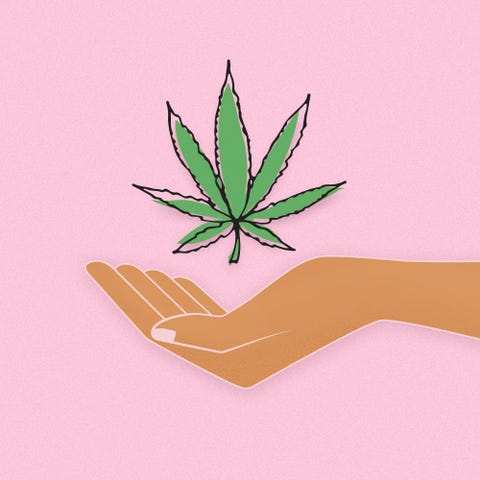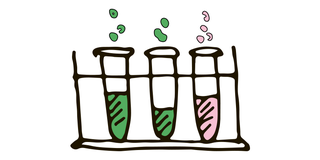Celebs Love CBD For Pain Relief—But Does It Actually Help?

Kristen Bell rubs it on post-workout to ease sore muscles. Olivia Wilde used it to relax her tight neck after being on Broadway for months. And Melissa McCarthy reportedly slathered it on her toes before the Oscars to prevent high heel pain. Plus, if we had to guess, you probably know someone who’s a fan, too.
Yup, we’re talking about cannabidiol, or CBD. CBD products are everywhere, with more and more cropping up on Instagram and in local health stores daily. But before you do like your favorite celeb and slather the stuff head to toe, it’s important to take the time to consider what we know—and what we don’t know—about using CBD to manage pain. Read on if you’ve been wanting to try it.
What’s CBD again, and why is it suddenly everywhere?
Getty Images
CBD is one of 100+ chemical compounds (called cannabinoids) found in the cannabis plant, which produces both marijuana and hemp. CBD is an extremely close chemical cousin of THC, which is the cannabinoid in marijuana that can give people a high. No matter how much CBD you consume, though, it cannot get you stoned.
CBD’s lack of psychotropic effects is what’s pushed it into the spotlight recently. “Given that a 1:1 combination of CBD to THC has proven beneficial to improve pain, we are hopeful that CBD alone will improve pain,” explains Kim Jones, PhD, FNP, FAAN, dean and professor of Nursing at Linfield College.
What’s more, at the end of September 2018, the Food and Drug Administration (FDA) approved the anti-seizure drug Epidiolex, which contains cannabis-sourced CBD. Regular cannabis is a Schedule I substance, which, according to the United States Drug Enforcement Administration (DEA), means it has no currently accepted medical use and a high potential for abuse. Epidiolex, on the other hand, is a Schedule V drug, which means it can be used to treat medical issues and has low potential for abuse.
.
“That really opened the door for a lot of CBD-only plant extract products,” Jones explains. Now, you can find CBD-infused oils, lotions, drinks, and more basically everywhere. Unlike Epidiolix, though, these products are considered nutraceuticals—not pharmaceutical drugs. This means they cannot make any health claims; however, no law prevents celebrities (or that hot dude from your gym) from telling you that they work.
As the anecdotal evidence continues to pile up, these products are slowly but surely being put into the spotlight. In turn, there has been a lot of hearsay and confusion regarding CBD’s efficacy. Which leads us to…
Can CBD actually help with pain?
At this point, there aren’t too many studies to back the growing pool of anecdotal evidence. A few test tube and animal studies have found that CBD may have anti-inflammatory properties, and pain is often related to inflammation. And according to some small, preliminary human trials, there’s a chance CBD may also help alleviate neuropathic pain (pain caused by nerve damage). It may also help manage cancer pain when combined with THC.
Despite this growing pool of research, “We don’t have what we’d want in terms of clinical trials on [CBD’s] safety and efficacy for anything beyond treatment of rare seizure disorder. We need more research,” says Ryan Vandrey, PhD, associate professor of psychiatry and behavioral sciences at Johns Hopkins Medicine
.
Why do people think CBD eases their pain if it might not?
It’s hard to say for sure, but studies suggest CBD may have an effect mood, which can can improve perceived pain.
Of course, though, CBD could just have a huge placebo effect. “Generally speaking, placebo is a very real response. It gives people about 30 percent relief,” Jones says. “The problem is, it doesn’t last very long. It may just be a few hours or a few days, and chronic pain lasts for life.”
So, is there any harm in trying it?
CBD seems to be safe and well-tolerated, and, unlike THC or opioids, there doesn’t seem to be a risk of dependence or abuse.
However, if you take blood thinners or anti-seizure drugs, do not take CBD, as it can interact with those medications. (And if you take any other medications, always talk to your doctor before trying something OTC.)
Illustration by Amy Armani
Another thing to consider is the lack of regulation. In a research letter published in JAMA in 2017, scientists tested 84 CBD products. A quarter of them contained less CBD than labeled. They also found THC in 18 of the products in large enough quantities to cause intoxication or impairment, especially among children.
If you want to give CBD a try, products that you put under your tongue and take sublingually (like drops) seem to be the most effective, Jones says. She suggests starting with a small dose and keeping a journal.
Rate your pain on a scale of 1 to 10 each day, and also note what else is going on, like if you didn’t get enough sleep. That way, you can see if the product is actually doing anything for you.
Source: Read Full Article



